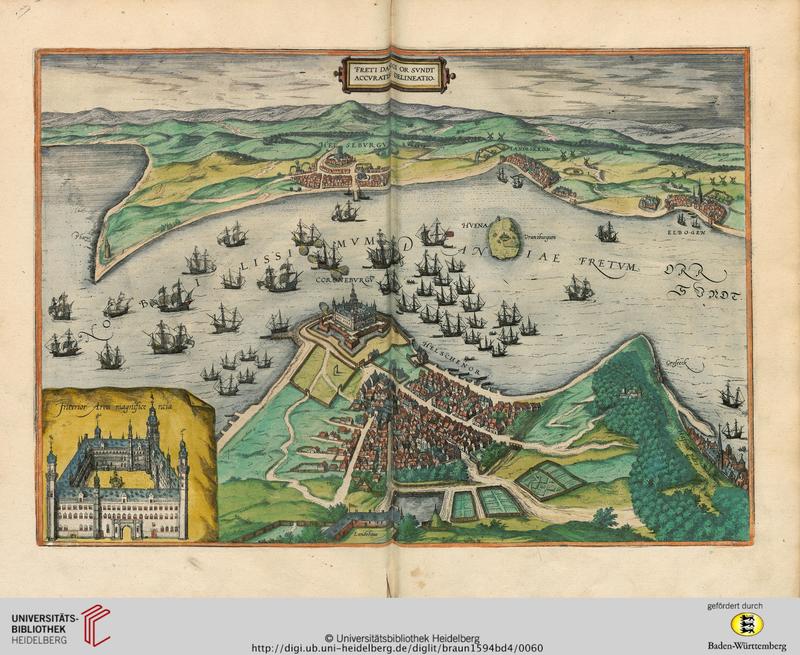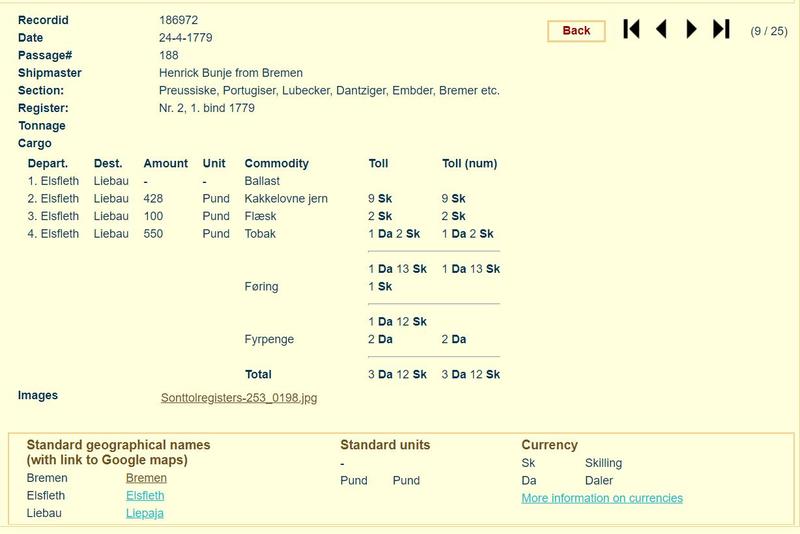Having Fun with a Unique Source: The Sound Toll Registers Online
On 17 May 1816, P.M. Mathiesen from Bergen (Norway) brought 104.85 tons barley, ca. 320 kg cannons, and stuff (krammerie) valued at 90 Rigsdaler from Stockholm to Holland. For this, he had to pay 30 daler and 19 shilling toll at Elsinore in the Øresund. Despite this seemingly random collection of goods, this is actually a pretty decent representation of what awaits historians diving deep into a unique source of early modern trade: the Sound Toll Registers.
The region surrounding the Baltic Sea produced and exported various bulk materials to markets in Western Europe, usually Hamburg, Amsterdam or London. These trading routes were well established by the Hanseatic merchants, travelling together from the Baltic coast and Northern German cities to reduce risks on the way. Typical products of the Baltic on Western markets were grain, especially rye, timber, iron, or copper. All large and bulky commodities, which were best transported on ships instead of tediously via land. Luckily, many rivers connected the vast production areas in Eastern or Northern Europe with ports on the Baltic Sea, and from there with the whole world. Unfortunately, there was only one strait suited to these large ships in and out of the Baltic. And this strait, the Øresound, was controlled on both sides by Denmark (until 1658, but the loss of one side of the strait did not change much). This geographical and political peculiarity was a continuous financial windfall for the Danish kings who established fortresses on both sides of the narrowest part of the Sound, and demanded a toll from all passing ships. This was also a windfall for historians - the large account books of this toll have survived, and give now insights into early modern trade relations, production, and shipping. These Sound Dues were collected between 1429 and 1857, and from 1574 onwards, the surviving registers are nearly complete.

View of the Sound, Braun, Georg; and Hogenberg, Frans: Civitates Orbis Terrarum IV, Cologne 1588, ©Universitätsbibliothek Heidelberg
Earlier research on the Sound toll registers already showed the immense quantities which were shipped back and forth. In 1906, the Danish historian (and later influential politician) Nina Ellinger Bang started a compilation of the nearly 700 preserved volumes (she focused, however, on 1497 to 1660) which are today stored by the National Archive in Copenhagen and occupy 60 shelf meters. The complete toll books contain about 1,8 million passages through the Sound between 1497 and 1857 in both directions (in and out of the Baltic Sea, usually said as going eastwards into the Baltic or westwards out of it, even though in practice the Sound is a North-South strait). Bang’s compilation, later continued by Knud Korst covering 1660 to 1783, had been the basis of fantastic quantitative research into early modern trade for more than 100 years. However, the sheer amount of data collected within the Sound Toll Registers urgently needed a computerized approach. Since 2007, the information from the registers has been entered into a huge database, available online here: http://www.soundtoll.nl/index.php/en/welkom. With this new database, it is now possible to really go into detail.
For the first time, it is now possible to quantify any trade and shipment which passed through the Sound (yes, there was smuggle and you could avoid the Sound, but this was quite difficult and not very extensive used). I have been mostly focussed on military goods such as cannons, gunpowder and saltpeter, firearms, or armour, and will soon be able to show in much more detail and quantified data how much (or how little) military goods were shipped in and out of the Baltic region. Since commodities are not (yet) standardized, researching this question meant to look through long, long, very long lists of commodities. These lists were spread out over 8 Excel-files, so I can only estimate, but in the end, I will have looked through probably around 350,000 unique terms and decided if they signified a war material, or not. Usually, the answer was “not”, but this is already a tiny spoiler for my next book.
And here is where the fun starts: Looking through the long lists of commodities and just seeing all the varied goods which were present in a small waterway at the edge of Europe 300 to 500 years ago is simply mindblowing. The sheer variety of products, but also the little insights into everyday life this offers are a source of constant amazement to me. Highlights include the many, many mentions of rabbit skin - while excluding them from my list of war material, I was wondering why on earth anybody would ship rabbit skin? Aren’t there enough rabbits in whatever market they were shipped to, and if not, would it not be more effective to just ship a few thousand rabbits and let nature take its course? Also, what could you possible need rabbit skins for, especially in such large amounts? For example, Thomas Huetter shipped 41,000 rabbit skins in 1566 from Kingston upon Hull somewhere into the Baltic (together with 99 pieces of three different textiles, just as a comparison; also the textiles were worth less than the rabbit skin). I still don’t know the answer for the first question (which country doesn’t have enough rabbits?), but the answer to the second one was solved a few weeks later when visiting a National Trust building. By chance, a table needed to be restored, and they did a small presentation about it. Apparently very important for early modern furniture was glue made from rabbit skin. It was also used for sealing oil painting, and very common in book binding. It was early modern superglue!
Rabbit skins were not the only surprising discovery - what really gave me a headache was Sarsaparilla, a middle American plant used to treat syphilis in this period (today a soft drink). Were the 200 pound “Saltze perery” Jan Janssen shipped in 1600 a wrong spelling of salpeter or a wrong spelling of Sarsaparilla? Searching an answer to this question mostly left me more amazed that already in 1600, a plant from Central America was so prominent and common on ships in Northern Europe. Another surprising commodity often shipped through this waterway was ivory: on 30 July 1589, Jann Jacobssen had 800 pound ivory (Elefanthe Been) on his ship, and only paid 11.5 shilling toll for it - quite cheap for such a good. And finally, why are so many tiled stoves (kakkelovne) shipped in both directions? If you have an explanation for this, please do contact me!
Altogether, deep diving into this database of the Sound Toll Registers opened up a whole new understanding of the entangled and varied trading world. Even before the establishment of trading companies in the 17th century (which was of course also visible in this data), goods from East Asia to Central America and Africa were commonly traded alongside grain from Poland-Lithuania or iron from Sweden. I am really looking forward to any further research into this, and how it will change our understanding of global connections.
Cathleen Sarti is Research Associate for The European Fiscal-Military System 1530 - 1870 and focuses on the Baltic case study.



